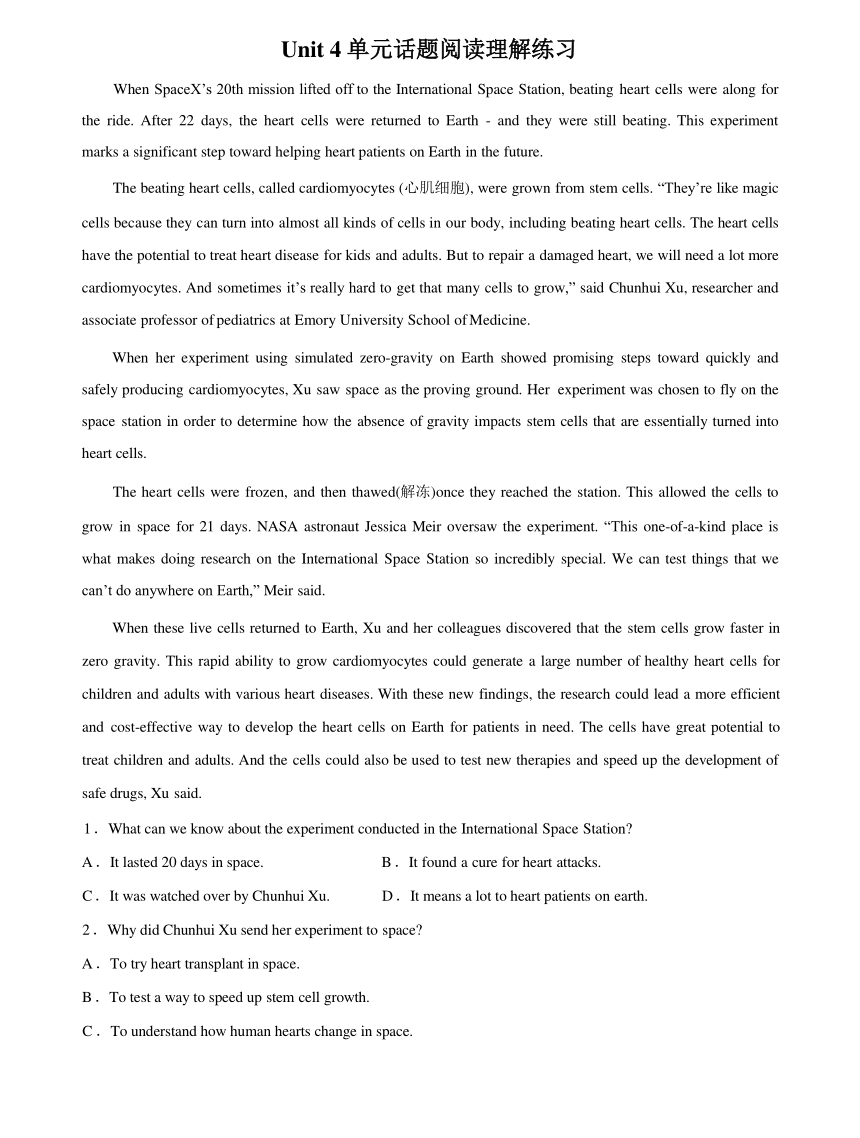
Unit 4 单元话题阅读理解练习 When SpaceX’s 20th mission lifted off to the International Space Station, beating heart cells were along for the ride. After 22 days, the heart cells were returned to Earth - and they were still beating. This experiment marks a significant step toward helping heart patients on Earth in the future. The beating heart cells, called cardiomyocytes (心肌细胞), were grown from stem cells. “They’re like magic cells because they can turn into almost all kinds of cells in our body, including beating heart cells. The heart cells have the potential to treat heart disease for kids and adults. But to repair a damaged heart, we will need a lot more cardiomyocytes. And sometimes it’s really hard to get that many cells to grow,” said Chunhui Xu, researcher and associate professor of pediatrics at Emory University School of Medicine. When her experiment using simulated zero-gravity on Earth showed promising steps toward quickly and safely producing cardiomyocytes, Xu saw space as the proving ground. Her experiment was chosen to fly on the space station in order to determine how the absence of gravity impacts stem cells that are essentially turned into heart cells. The heart cells were frozen, and then thawed(解冻)once they reached the station. This allowed the cells to grow in space for 21 days. NASA astronaut Jessica Meir oversaw the experiment. “This one-of-a-kind place is what makes doing research on the International Space Station so incredibly special. We can test things that we can’t do anywhere on Earth,” Meir said. When these live cells returned to Earth, Xu and her colleagues discovered that the stem cells grow faster in zero gravity. This rapid ability to grow cardiomyocytes could generate a large number of healthy heart cells for children and adults with various heart diseases. With these new findings, the research could lead a more efficient and cost-effective way to develop the heart cells on Earth for patients in need. The cells have great potential to treat children and adults. And the cells could also be used to test new therapies and speed up the development of safe drugs, Xu said. 1 .What can we know about the experiment conducted in the International Space Station A .It lasted 20 days in space. B .It found a cure for heart attacks. C .It was watched over by Chunhui Xu. D .It means a lot to heart patients on earth. 2 .Why did Chunhui Xu send her experiment to space A .To try heart transplant in space. B .To test a way to speed up stem cell growth. C .To understand how human hearts change in space. D .To study the effects of microgravity on brain cells. 3 .What did Xu and her colleagues find A .It’s really hard to get stem cells to grow on the space station. B .The heart cells were easy to froze and thaw on the space station. C .Zero gravity is ideal for stem cells to grow. D .It is costly to grow stem cells. 4 .What can the new findings contribute to A .Test novel treatments B .Eliminate dru ... ...
~~ 您好,已阅读到文档的结尾了 ~~

